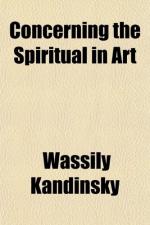And so at different points along the road are the different arts, saying what they are best able to say, and in the language which is peculiarly their own. Despite, or perhaps thanks to, the differences between them, there has never been a time when the arts approached each other more nearly than they do today, in this later phase of spiritual development.
In each manifestation is the seed of a striving towards the abstract, the non-material. Consciously or unconsciously they are obeying Socrates’ command—Know thyself. Consciously or unconsciously artists are studying and proving their material, setting in the balance the spiritual value of those elements, with which it is their several privilege to work.
And the natural result of this striving is that the various arts are drawing together. They are finding in Music the best teacher. With few exceptions music has been for some centuries the art which has devoted itself not to the reproduction of natural phenomena, but rather to the expression of the artist’s soul, in musical sound.
A painter, who finds no satisfaction in mere representation, however artistic, in his longing to express his inner life, cannot but envy the ease with which music, the most non-material of the arts today, achieves this end. He naturally seeks to apply the methods of music to his own art. And from this results that modern desire for rhythm in painting, for mathematical, abstract construction, for repeated notes of colour, for setting colour in motion.
This borrowing of method by one art from another, can only be truly successful when the application of the borrowed methods is not superficial but fundamental. One art must learn first how another uses its methods, so that the methods may afterwards be applied to the borrower’s art from the beginning, and suitably. The artist must not forget that in him lies the power of true application of every method, but that that power must be developed.
In manipulation of form music can achieve results which are beyond the reach of painting. On the other hand, painting is ahead of music in several particulars. Music, for example, has at its disposal duration of time; while painting can present to the spectator the whole content of its message at one moment. [Footnote: These statements of difference are, of course, relative; for music can on occasions dispense with extension of time, and painting make use of it.] Music, which is outwardly unfettered by nature, needs no definite form for its expression.
[Footnote: How miserably music fails when attempting to express material appearances is proved by the affected absurdity of programme music. Quite lately such experiments have been made. The imitation in sound of croaking frogs, of farmyard noises, of household duties, makes an excellent music hall turn and is amusing enough. But in serious music such attempts are merely warnings against any imitation of nature. Nature has her own language, and a powerful one; this language cannot be imitated. The sound of a farmyard in music is never successfully reproduced, and is unnecessary waste of time. The Stimmung of nature can be imparted by every art, not, however, by imitation, but by the artistic divination of its inner spirit.]




